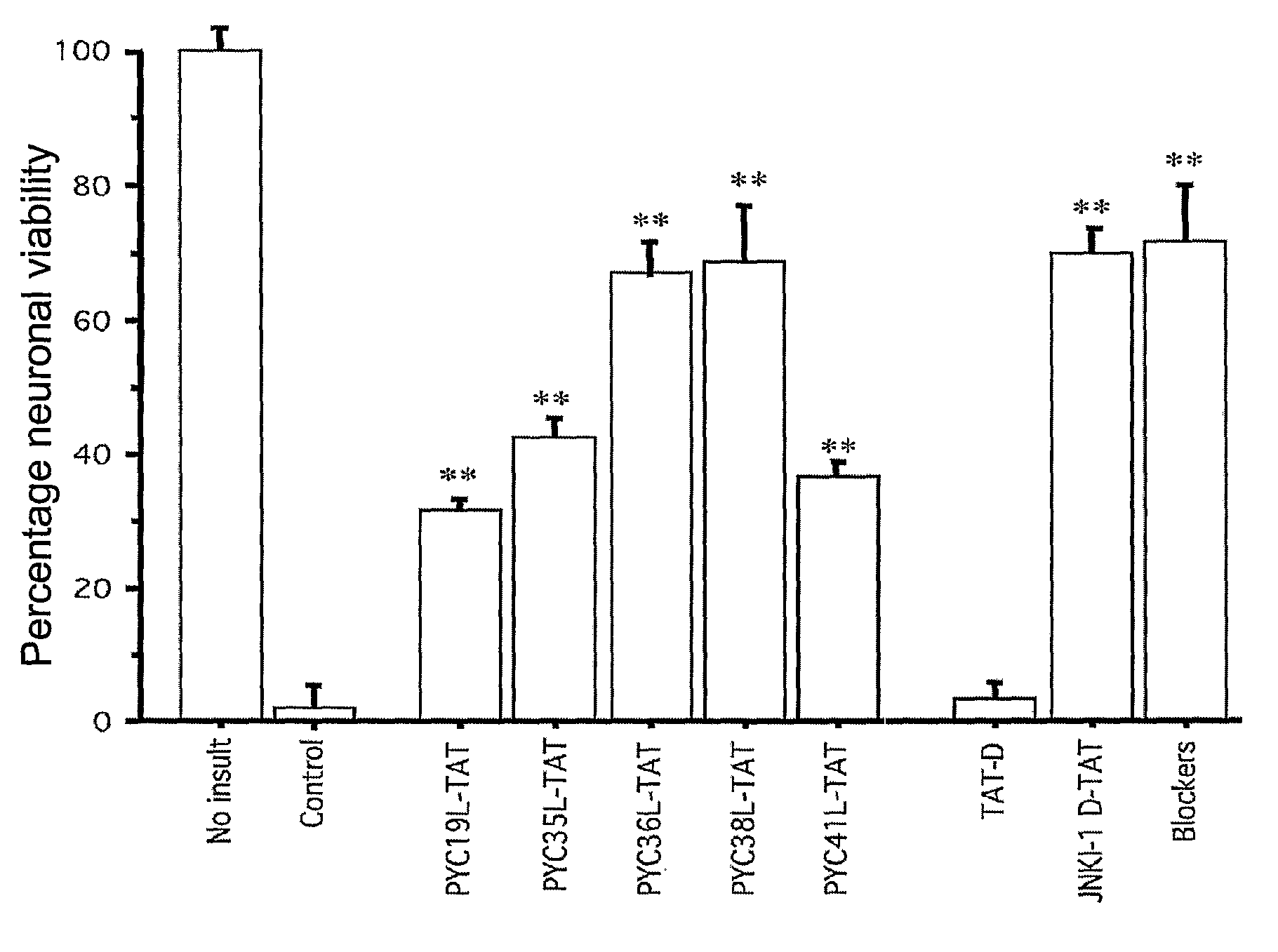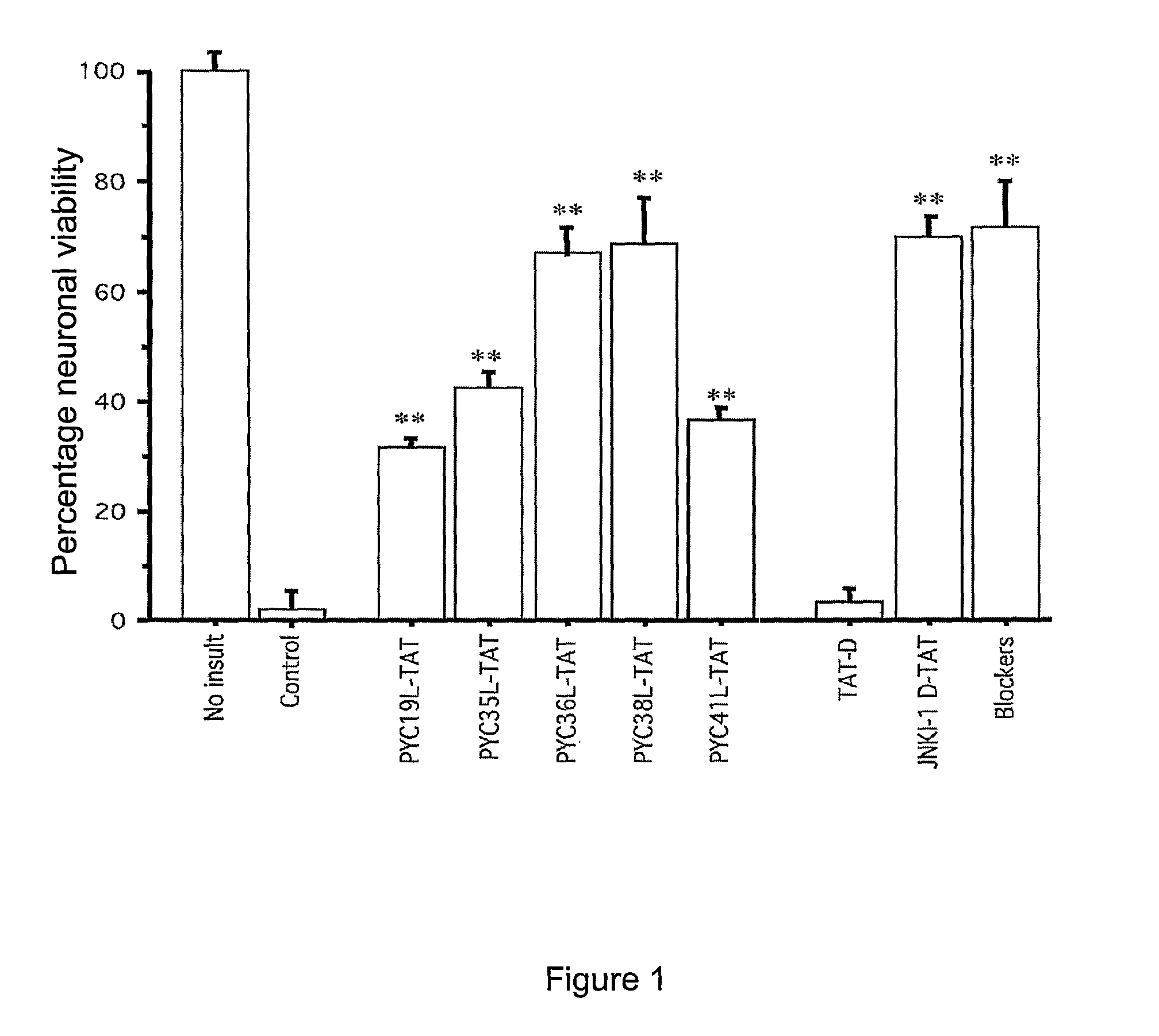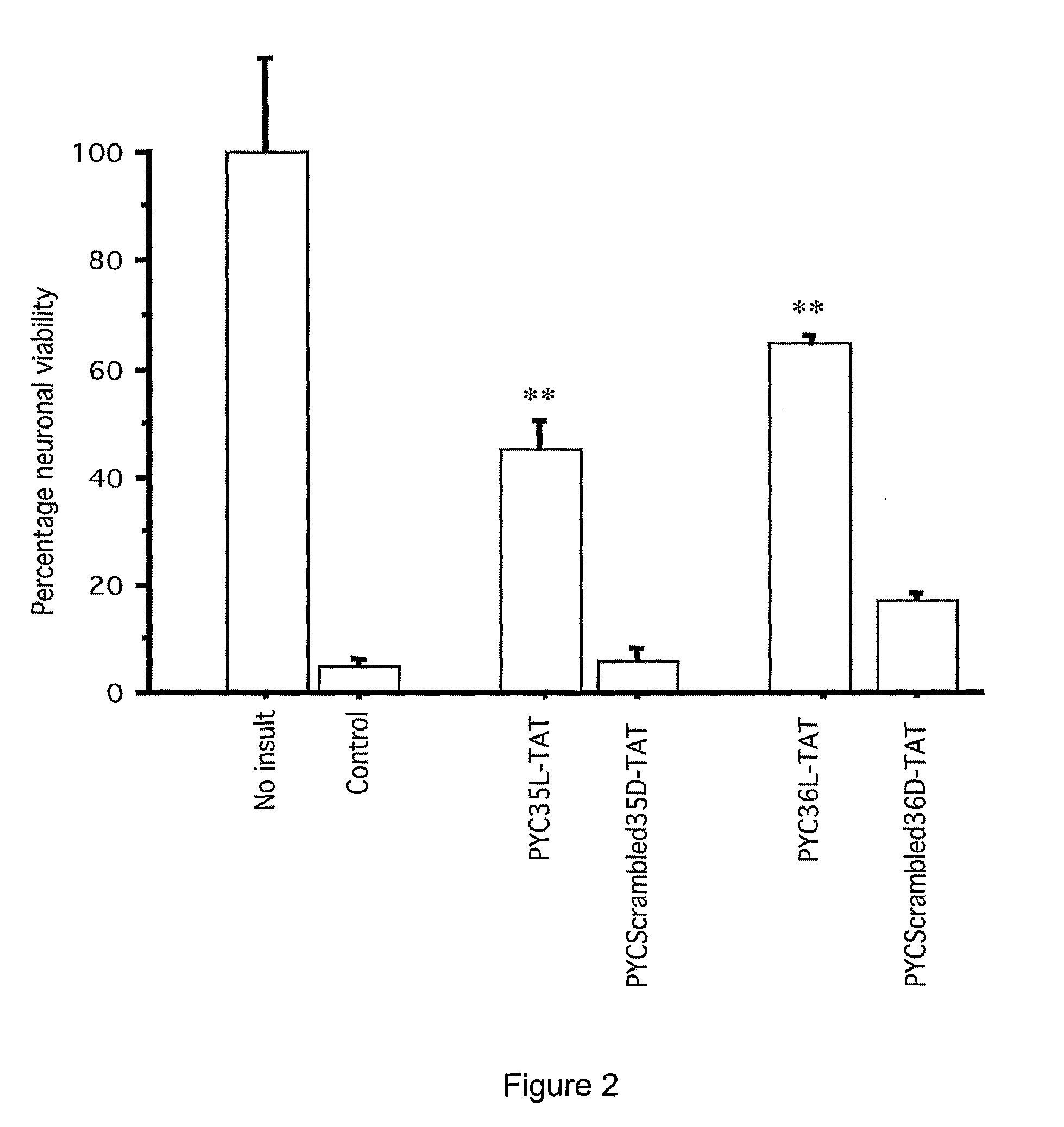Neuroprotective peptide inhibitors of AP-1 signaling and uses therefor
a technology of neuroprotective peptides and inhibitors, which is applied in the field of neuroprotective peptide inhibitors of ap-1 signaling, can solve the problems of complex and expensive synthesis, low affinity, and difficulty in delivery via non-injectable routes, so as to reduce the loss of neurons, reduce the activation of microglia, and reduce the effect of astrogliosis
- Summary
- Abstract
- Description
- Claims
- Application Information
AI Technical Summary
Benefits of technology
Problems solved by technology
Method used
Image
Examples
example 1
Isolation of AP-1 Complex Formation Inhibitory Phylomer™ Peptides
Phylomer™ Peptide Library Construction
[0203]Genomic DNA from 15 different sequenced bacterial genomes (Aquifex aeolicus, Bacillus subtilis, Bordetella pertussis, Borrelia burgdorferi, Chlamydia trachomatis, Escherichia coli K12, Haemophilus influenzae, Helicobacter pylori, Methanobacterium thermoautotrophicu, Methanococcus jannashii, Neisseria meningitides, Pyrococcus horikoshi, Pseudomonas aeruginosa, Synechocystis PCC 6803, Thermoplasma volcanicum) was obtained. This DNA was used as the template for random amplification using random primers containing a FLAG-tag, designated BGFN6 and BGFN9, as follows:
BGFN6:5′-GACTACAAGGACGACGACGACAAGGCTTATCAATCAATCANNNNNN-3′;BGFN9:5′-GACTACAAGGACGACGACGACAAGGCTTATCAATCAATCANNNNNNNNN-3′
[0204]The following protocol was employed:
Amplification Round 1: 3.33 μM Klenow primer, 1× Klenow buffer, 200 μM dNTPs, Klenow, PEG (8500) in total volume of 30 μl. Mix primer, DNA, and water; boil for...
example 2
Phylomer™ Peptides that Decrease AP-1 Controlled Reporter Gene Expression
[0214]Phylomer™ peptides that inhibit an AP-1 complex formation as described in Example 1 were tested for their ability to decrease AP-1 controlled reporter expression (since Jun dimers are AP-1 moieties). A transient transfection assay in which the expression of each clone was plasmid driven was employed, thereby avoiding the synthesis of large numbers of peptides.
Luciferase Reporter Gene Assay of AP-1 Dependent Transcriptional Activity
[0215]The K562 cell line was stably-transfected with the AP-1 luciferase reporter (AP1-Luc) of the Mercury Pathway Profiling kit (Clontech, U.S.A.), and the clonal cell line K562 / AP1-Luc was established. In 6-well tissue culture plate format, K562 / AP1-Luc cells were transfected with either pcDNA3 control, pcDNA3-JunDN (a dominant negative mutant of c-Jun), or pcDNA3-peptide, using Lipofectamine2000 (Life Technologies) according to manufacturer's instructions. Transfection reacti...
example 3
Peptides that Inhibit AP-1 Signaling are Neuroprotective Following Glutamate Excitotoxicity in Primary Cortical Neuronal Cultures
Materials & Methods
1. Peptides
[0218]Peptides used in this example comprise the amino acid sequences shown in the accompanying Sequence Listing. The peptides were designated as shown in Table 1.
TABLE 1SEQ IDPeptide NameDescriptionSequenceNO.PYC19LPhylomer™ core sequenceLen Ile Asn Gln Ser Tyr Ala Tyr Pro Tyr Ile TyrSEQ ID NO: 28PYC19DRetroinverted form of PYC19LaTyr Ile Tyr Pro Tyr Ala Tyr Ser Gln Asn Ile Len GlySEQ ID NO: 29PYC19L-TATPYCl9L with an N-terminal TATGly Arg Lys Lys Arg Arg Gln Arg Arg Arg Gly Leu IleSEQ ID Asn Gln Ser Tyr Ala Tyr Pro Tyr Ile TyrNO: 30PYCl9D-TATRetroinverted PYC19L-TATbTyr Ile Tyr Pro Tyr Ala Tyr Ser Gln Asn Ile Leu GlySEQ ID Arg Arg Arg Gln Arg Arg Lys Lys Arg GlyNO: 31PYC19L-FMPYC19L with C-terminal KaposiLen Ile Asn Gln Ser Tyr Ala Tyr Pro Tyr Ile Tyr GlySEQ ID FGF protein transduction domainAla Ala Val Len Leu Pro Val Len L...
PUM
| Property | Measurement | Unit |
|---|---|---|
| time | aaaaa | aaaaa |
| time | aaaaa | aaaaa |
| total volume | aaaaa | aaaaa |
Abstract
Description
Claims
Application Information
 Login to View More
Login to View More - R&D
- Intellectual Property
- Life Sciences
- Materials
- Tech Scout
- Unparalleled Data Quality
- Higher Quality Content
- 60% Fewer Hallucinations
Browse by: Latest US Patents, China's latest patents, Technical Efficacy Thesaurus, Application Domain, Technology Topic, Popular Technical Reports.
© 2025 PatSnap. All rights reserved.Legal|Privacy policy|Modern Slavery Act Transparency Statement|Sitemap|About US| Contact US: help@patsnap.com



